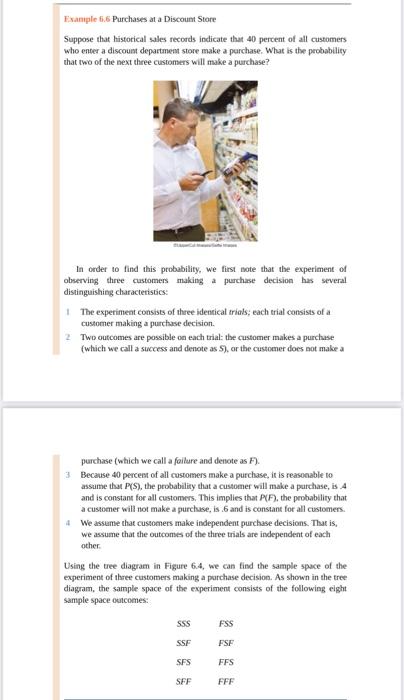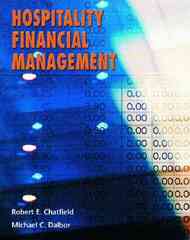Exanple 6.6 Purchases at a Discoumt Store Suppose that historical sales records indicate that 40 percent of all customers who enter a discount department store make a parchase. What is the peobability that two of the next three customers will make a purchase? In order to find this probability, we first note that the experiment of observing three customers making a purchase decision has several distinguishing characteristics: 1 The experimeat consists of three identical trials; each trial consists of a customer making a purchase decision. 2. Two outcomes are possible on each trial: the customer makes a purchase (which we call a success and denote as S), or the customer does not make a purchase (which we call a foilure and denote as F). 3 Becatse 40 perces of all costomers make a purchase, it is reasocable to assume that P(S), the probability that a customer will make a parchase, is .4 and is constans for all customers. This implies that P(F), the probablity that a custoener will not make a purchuse, is .6 and is constant for all costomers. 4. We assume that cussomers make independent purchase decisions. That is, we assume that the outcomes of the three trials are independent of each other. Using the tree diagram in Figure 6.4, we can find the sample space of the experiment of three customers making a parchase decision. As shown in the tree diagram, the sample space of the experiment consists of the following eight sample space ouncomes: Exanple 6.6 Purchases at a Discoumt Store Suppose that historical sales records indicate that 40 percent of all customers who enter a discount department store make a parchase. What is the peobability that two of the next three customers will make a purchase? In order to find this probability, we first note that the experiment of observing three customers making a purchase decision has several distinguishing characteristics: 1 The experimeat consists of three identical trials; each trial consists of a customer making a purchase decision. 2. Two outcomes are possible on each trial: the customer makes a purchase (which we call a success and denote as S), or the customer does not make a purchase (which we call a foilure and denote as F). 3 Becatse 40 perces of all costomers make a purchase, it is reasocable to assume that P(S), the probability that a customer will make a parchase, is .4 and is constans for all customers. This implies that P(F), the probablity that a custoener will not make a purchuse, is .6 and is constant for all costomers. 4. We assume that cussomers make independent purchase decisions. That is, we assume that the outcomes of the three trials are independent of each other. Using the tree diagram in Figure 6.4, we can find the sample space of the experiment of three customers making a parchase decision. As shown in the tree diagram, the sample space of the experiment consists of the following eight sample space ouncomes







